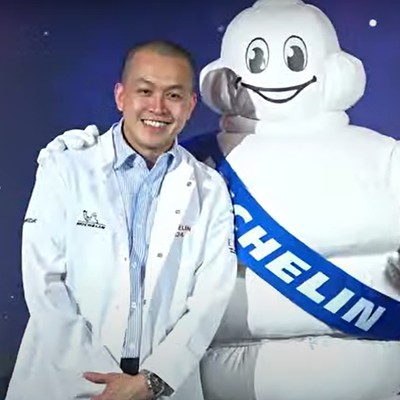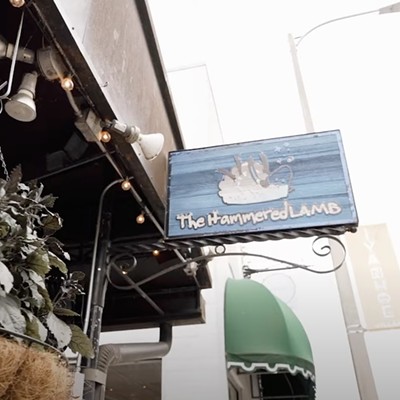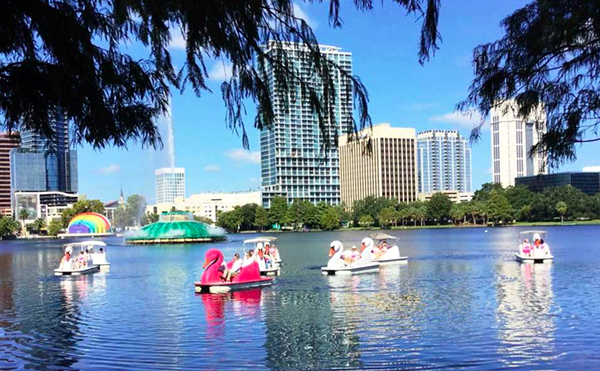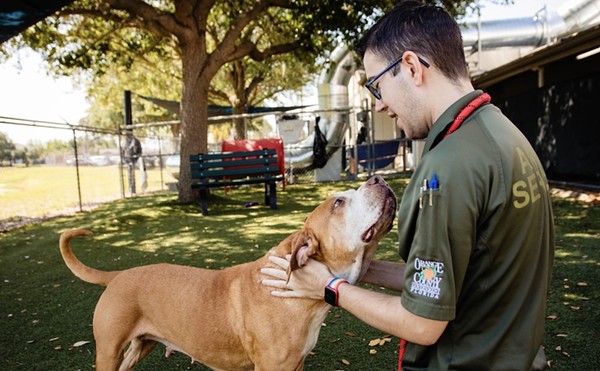Not everyone is blinded by the science at Orlando's new $44 million showplace When I optimistically entered the ballyhooed Orlando Science Center my hopes were instantly dashed by the largest object on display. There, in the core of the lovely new building, stood a plastic cyprus tree. With a badly stuffed great blue heron, no less. "of course!' I mutteres. "This is Orlando. My hometown. Ask for a world-class museum, you get Disney World." Thenm having studied the diagram showing her four-s=tory floor plan for a few minutes, I asked the ticket ckerk if there night be an optimum ruote for exploration. "We're still trying to figure that out," she replied. Somehow I had imagined that museum architecture involved moving people smoothly through exhibits. Uh-oh, I thought. Disney without traffic control. Understand this: I love museums. I enjoy math. I read a lot of science books. I hike, paddle and drive all over the continent to see birds and beasts and trees and rocks and buildings and bridges. I own a star chart and marvel at comets and eclipses. I know learning is fun. And it all started as a kid. When I was little my Mom took me to the Field Museum of Science and Industry in Chicago, and later their counterparts in New York. There was a tiny, underfunded little Trailside Museum in my first neighborhood. I spent grade-school afternoons pestering the harried staff person with questions. I saw things which have taken me 40 years to understand. I was exposed to ideas that made me want to keep learning. One of the big disappointments of my childhood move to Central Florida was the dearth of such sources of inspiration. They are still missing. As an adult I have wandered the halls of science in Boston, New york, Philadelphia and the incomparable Smithsonian Institution in Washington, D.C. I frequent explanatory displays at national and state parks that describe plate tectonics and vulcanism, estuarine life cycles or hydroelectric turbines. I am an unabashed science buff, but I am not a professional. I am a carpenter, an average person who visits museums. Before I explain my deep disappointment with Orlando's newest tourist attraction, it is only fair to mention its success. The Acadamy Award-nominated IMAX film, "The Living Sea," is breathtaking and educational. There is that reliable museum stand-by, a kid pleasing scale that shows your weight on other planets. The observatory dome is very shiny and the covered walkway from the parking decks to the Hall of Money Changers will keep your head dry during inclement weather. Nor will I complain about the many dysfunctional displays, including the planetarium, which was labeled "Out of Order" on my visit. After a couple of weeks of public abuse, stuff is apt to break down. You can't expect a $44 million-dollar gizmo to last forever. Even the space shuttles explode, and I've seen space shuttles. This is not a space shuttle. The failure of the Orlando Science Center is systemic. There was such an intense effort to make it a hands-on participatory experience, that the designers lost sight of what the hands were supposed to be grasping for. To wit: A nutrition wheel-of-fortune lets one dial up a fast-food meal that is instantly analyzed for fat and sugar content. Nowhere does one find a suggestion of what a "good" score might be. I watched people dial up a couple of favorites, Macburgers or Kernelchicken, read, "215 - oh," and walk on unenlightened. Amidst all of the ersatz body parts sits one real piece of person, a half brain in a jug. No explanation. Just a curious hunk of meat. And a chart of the health effects of drug use includes a graphic depiction of a bullet in the brain. This is science? Designers carefully constructed a full-sized kitchen to illustrate math used in cooking. Nice cabinets, but one senses butter cut with a chainsaw. A set of measuring cups would make the same point with considerably less fuss. The profound importance of mathematics erupts in a roomful of board games of the sort that thoughtful parents would play at home with the tykes. A crowded and very noisy museum is a terrible place for thoughtful gaming. In a soundproof room you are invited to create a sound track for a movie clip. Two computer displays with mice and a microphone have no apparent effect on the dinosaur video overhead. No instructions. I am computer literate and could not make anything meaningful happen. This experience was repeated at other computer stations. While exploring the Science of Movie Making (why didn't that surprise me?), we can sit in a make-up chair and pretend we are a character in "Star Trek." Neato. (Gosh, Mr Wizard! Science is just like Universal Studios!") The Cosmic Tourist promises "Earth & Beyond" but delivers video re-runs of shuttle space walks and a roomful of shiny plastic models. You can use very high-tech looking terminals to read fascinating information about other planets. You could look up the same information in the public library. The library is free (and quiet!). But hold onto your hats, folks! tThe little earthquake simulator actualy moves! Fun? Yes. Learning ? (?) Throughout the center, heavy reliance on computer stations wastes money and space, even if missing instructions were provided. Keyboards and mice are tyrannically non-participatory. One person instantly monopolizes each site: other visitors watch for a few moments and move on. (I watched a bored young Mom bounce a toddler on her shoulder while Dad played a computer game, and sensed that this same scene was played out at home: the child learns the important lesson that computers are a guy thing.) Everywhere you look, this technophile approach emerges in whizbang displays and flashing lights. But it is too dumbed down to engage a normal high-school graduate, and too complex to intrigue a child. Planners have fallen prey to the fallacty that putting a computer in front of a youngster is inevitably educational. It is often simply glorified TV. After departing, I drove past the lake just north of Loch Haven Park and clearly understood my disappointment. Here were real cypress trees and a real heron just a few hundred yards from their faux cousins. There were no fake trees in the museums of my youth; indeed, there wasn't much fake anything. The Foucault pendulum in the Chicago science museum was hard to understand when I was five, but it showed me something profoundly true about the earth's motion and gravity that tugged at my curiosity. Years later, with a much better grasp of physics. That potent image remains. Four days later along the edge of that same lake I spotted a wood stork (endangered), and the irony caused a grim chuckle. The wood stork population is disappearing along with its habitat. As we pave Florida and convert hammocks and wetlands to highways, housing tracts, shopping malls and, yes, science centers, we ensure that future generations will find strange and wonderful creatures like the wood stork only in museums. Probalby badly stuffed. How weird that this new temple is touted as an "attraction," meaning, of course, an attractor of people. More people. Less storks. As the Orlando Sentinel's "User's Guide to the Orlando Science Center" gushed, "NatureWorks is an ideal way to revel in the splendor of the great outdoors in air-conditioned comfort." Hoo-boy. Somehow, a 7,000-square-foot display didn't shout "Great Outdoors" to me; it whispered "Big Terrarium." The trouble with viewing the natural world "in air conditioned comfort" is obviously that it is no longer the natural world being viewed. It is "honey bees nestled in a lifelike fabricated tree." But is it lifelike to the bees? If you drive a half hour or more to visit the Big Terrarium, you pass lots of truly great outdoor places, even within the city limits. There is more real wildlife at Lake Eola Park than in NatureWorks. Point your car in the other direction and a half hour will take you to places where you can watch alligators, turtles, fish and birds doing their thing as they were meant to do it. Air-conditioned comfort creates a borderline ice-age for a gator; outdoors, turtles crawl on logs to sit in the sun. The real sun. My advice to those who want to inspire children with a love of learning and science is this: Buy a couple of field guides and take them to see a real cypress tree and a real heron. If you perspire a bit, talk about the wonderful cooling system installed in human skin. If a mosquito makes an appearance. Talk about the aquatic food chain. Show them how to look up answers at the library. Cook together: explain tablespoons and measuring cups. Go watch a shuttle launch. Explain levers and pendulums when you ride teeter-totters and swings. But don't waste your time at the Orlando Science Center. Disney is way more fun.
Tags:

WE LOVE OUR READERS!
Since 1990, Orlando Weekly has served as the free, independent voice of Orlando, and we want to keep it that way.
Becoming an Orlando Weekly Supporter for as little as $5 a month allows us to continue offering readers access to our coverage of local news, food, nightlife, events, and culture with no paywalls.
Scroll to read more Arts Stories + Interviews articles
Newsletters
Join Orlando Weekly Newsletters
Subscribe now to get the latest news delivered right to your inbox.















